
Wine Culture and Information since 2002 - Volume 22
 Wine Culture and Information since 2002 - Volume 22 |
|
Contrasts of Moscato di Trani and Trentino Vino SantoMuscat Blanc and Nosiola compared in the glasses of this month's tasting by contrast, in a rich and special style, with wines produced from dried grapes. |
|
The world of wine is so varied and surprising that in case we change some factors in the environmental, viticultural and enological conditions, we obtain different results, often unpredictably. Changes and results leading to the creation of wines with very different personalities and characters, especially from a sensorial point of view, despite being produced with the same grape. Let's think, for example, of a wine produced with grapes harvested in the same vineyard and after a few weeks or even a month. This not so superficial viticultural factor, therefore productive, is to be considered crucial as those grapes – the same but with different level of ripeness – not only require specific enological practices, above all they lead to the creation of completely different wines. In other words, if it is true that grapes not yet perfectly ripe are suitable for the creation of sparkling wines, they are totally unsuitable for the production of a sweet wine. Sweet wines, in particular those produced with dried grapes, often express very different characters compared to the “dry table styles” produced with the same grapes. These wines share common sensorial characteristics, especially olfactory ones, when they are produced with the so-called aromatic varieties, as this exuberant quality is preserved regardless of the style of wine. Italy is certainly among the wine-making countries in the world having the greatest wealth and variety of sweet wines from dried grapes, virtually every region has the full right to identify itself in at least one sweet wine produced with dried grapes. Furthermore, many of these wines take on enological and historical importance such as to be recognized in the Italian wine quality system, both in the context of territories and disciplinary made of different wines, as well as in dedicated enological areas. The two wines we are examining in this month's tasting by contrast belong, in fact, to both types of territories. The first of them – Moscato di Trani – is defined in a disciplinary exclusively created for this wine, whereas the second one – Trentino Vino Santo – is included in an appellation also providing for the production of other wines and styles.
|
|
Apulia is among the main regions of Italy in terms of wine production. In this large Italian region, in fact, the production of wine represents on average and in quantitative terms, about one fifth of the entire country. Among the sunniest regions of Italy, here the grapes reach full ripeness and with important sugar contents which translate, not least, into alcoholic wines and often of considerable structure. It is no coincidence, in fact, that Apulia is historically one of the main regions where wines for blending are produced and used to “reinforce” certain wines, so to speak, “light” and produced in others wine territories. Among the many wines of Apulia, Moscato di Trani certainly stands out for its undeniable finesse and its important history, in some respects, an exceptional and rare case in the wine scene of the region. It is, in fact, a sweet wine produced with dried white grapes, specifically, with Muscat Blanc which, in accordance with the production disciplinary of the relative Denominazione d'Origine Controllata (Denomination of Controlled Origin, DOC) represents the main share. It is, not least, a wine with a long and prestigious history, protagonist of important commercial events of the past. In fact, around the year 1000, the quality and prestige of this wine was such as to attract the interest of Venetian merchants, so much to sign a specific agreement with the “Customs of Trane”. The export was then regulated, in fact limited, in the fourteenth century by Roberto d'Angiò – at the time, Count of Trani – an event that aroused the disappointment of Venetian merchants. Furthermore, Moscato di Trani had a prominent mention in the famous book “Descrittione di tutta l'Italia” (Description of all Italy) by Leandro Alberti, who – speaking of this Apulian wine – defined it as “so excellent that it is very delicate to taste”. Moscato di Trani has been recognized as a Denominazione d'Origine Controllata (Denomination of Controlled Origin, DOC) since 1974 and its production provides for the use of Muscat Blanc grape – also known here as “Moscato di Trani ” or “Reale” – for at least 85%, while the remainder can be represented by white grape varieties having a “muscat aroma” and allowed for cultivation in the province of Bari. Moscato di Trani is produced in the “naturale dolce” (naturally sweet) and “liquoroso” (fortified) styles.
|
||||
|
In the vast wine scene of Trentino, there is a rare pearl produced with the Nosiola grape, a native variety of this region. Trentino Vino Santo, in fact, is among the enological excellence produced in this region. This wine is made in the Valle dei Laghi area, in the south-western part of the region – not far from Trento – and, in particular, near Lake Toblino, considered among the reference territories for the production of Trentino Vino Santo. The first evidence of sweet wines from dried grapes produced in these lands dates back to the early 1500s, in particular a document dated 1508 in which it is mentioned in the annual payments of the captain of Castel Toblino in favor of the bishop of Trento. Moreover, the fame of this wine also reached the lands of the former Habsburg Empire, just like the wines of that era produced in Trentino. With the end of the First World War, the production of Trentino Vino Santo begins to decline, a period of oblivion interrupted a few decades ago, when it was restored the prestige and fame this glorious wine deserve. Trentino Vino Santo is now recognized as a Denominazione d'Origine Controllata wine (Denomination of Controlled Origin, DOC) and belonging to the Trentino regional appellation. The production provides for the use of dried Nosiola grapes – for a minimum of 85% – while the remaining part can be made up of non-aromatic white grape varieties allowed to cultivation in Trentino. The drying of the grapes is carried out in racks – locally called arèle – an operation that often leads to the development of the botrytis cinerea, also known as “noble rot”, the main responsible for the future organoleptic characteristics of this wine. The drying generally lasts until March, and then proceeds with the crushing, therefore the fermentation, generally carried out in cask. At the end of this phase, the producers generally decide to let Trentino Vino Santo age for several years in the same fermentation barrels, despite the fact for the superior style, the production disciplinary provides for a minimum of 48 months. This period is fundamental for the development of its complexity and richness, which is why there is generally a tendency of producers to deliberately increase the periods set by the production specification.
|
Before starting this month's tasting by contrast, we need to buy the two wines first. In this regard, it must be said these are wines with decidedly limited and reduced productions, therefore their finding could present some difficulties. Moscato di Trani and Trentino Vino Santo are in fact produced in rather limited territories, also considering that the production is made only by a few wineries. This month's tasting is also characterized by the enological differences that usually distinguish Moscato di Trani and Trentino Vino Santo. In fact, it should be noted that, contrary to what is stated for Trentino Vino Santo, the type of container to be used for aging – in accordance with its production disciplinary – is not provided for the Apulian sweet wine. The choice of producers of Moscato di Trani is generally in favor of inert containers, while the aging of Trentino Vino Santo must necessarily be carried out in wooden barrels. As for the vintage, we will choose wines that do not have big differences in this sense. Moscato di Trani and Trentino Vino Santo are poured into their respective tasting glasses at a temperature of 15 °C. (60 °F) We can now begin this month's tasting by contrast, by examining – as usual – the appearance of the two wines, starting with Moscato di Trani. We therefore tilt its glass over a white surface – a sheet of paper is enough – and observe the base, where the thickness of the wine is greater. The Apulian wine shows a bright amber yellow color and good transparency, this latter aspect evaluated by placing an object between the glass and the white surface. Let's now turn our attention to the opening of the glass, where the thickness of the wine becomes thin, and observe the color of the nuance. The Apulian wine is characterized by an amber yellow color and often tending to golden. Let's now pass to the evaluation of the aspect of Trentino Vino Santo and, as for the previous wine, we tilt its glass over the white surface. The color shows an intense amber yellow, generally darker than that of Moscato di Trani. Also in this case, the transparency is high and allowing the vision of the object placed in contrast between the glass and the white surface. The nuance of Trentino Vino Santo confirms the base color, that is amber yellow. The evaluation of the olfactory profiles of Moscato di Trani and Trentino Vino Santo certainly allow the perception of common elements because of the particular enological technique used for their production, that is the drying of the grapes. This characteristic, in fact, tends to concentrate and strengthen certain sensorial qualities that can be found in almost all of this kind of sweet wines, in particular the aroma and flavor of dried grapes. In the specific case of the wines of this month's tasting by contrast, we need to consider the specific type of grapes, in particular an aromatic variety – Muscat Blanc, used for the Apulian wine – and a non-aromatic variety, that is Nosiola used for Trentino Vino Santo. This characteristic determines the enormous olfactory difference existing between the two wines, as Muscat Blanc – even when used for dried sweet wines – keep its exuberant and characteristic aroma. Let's resume our tasting and proceed with the analysis of the olfactory profiles of the two wines, starting – as in the previous phase – with the examination of Moscato di Trani. Let's hold the glass in vertical position and, without swirling, proceed with the first smell in order to analyze the opening of the wine, that is its primary and identifying sensations. From the glass we can immediately perceive the intense and exuberant aroma of the characteristic aromaticity of Muscat Blanc, recognizable by the clear aroma of grape must. In addition to this, we can also perceive the aromas of dried fig, banana and broom. After having swirled the glass, let's proceed with the second smell. We can now perceive the aromas of honey, citrus peel, chamomile, candied fruit, peach jam, date, orange blossom, lavender and almond. Let's now pass to the evaluation of the olfactory profile of Trentino Vino Santo, and proceed with the first smell. From the glass we can perceive, intense and clean, the aromas of raisins, dried figs, honey and candied fruit. After having swirled the glass and carried out the second smell, the olfactory profile of the wine is completed with dried apricot, citrus fruit, caramel, peach jam, quince jam, almond, walnut and vanilla, the latter mainly contributed by the aging in cask. Let's now pass to the evaluation of the gustatory profiles of Moscato di Trani and Trentino Vino Santo, starting with the examination of the attack of the Apulian wine, that is, the identifying and initial sensory qualities that are perceived in the mouth at the first sip. The attack of Moscato di Trani is, as easily predictable, sweet and round, with the effect of alcohol well perceptible. Balance is obtained thanks to the precious contribution of acidity – well perceptible and crisp – such as to counteract the effects of the other sensations. In the mouth we clearly perceive the flavor of grapes as well as banana and dried fig, confirming the good correspondence with the nose. Let's now take a sip of Trentino Vino Santo in order to evaluate its attack. Also in this case, the primary gustatory sensations we perceive in the mouth are sweetness and roundness, together with the effect of the alcohol. The wine is promptly balanced, also in this case, by the crispness given by the acidity. Moreover, in the mouth are perceived the intense flavors of raisins, dried figs, honey and candied fruit. We have reached the final phase of our tasting by contrast, in which we examine the sensations the wines leave in the mouth after swallowing, in particular the taste-olfactory persistence. The finish of Moscato di Trani is persistent, leaving in the mouth the perception of both sweetness and roundness, and the refreshing contribution of acidity, therefore expressing a perfect balance even in the final phase. In the mouth – intense and clean – we can continue to perceive the flavors of grapes, banana and dried figs. The finish of Trentino Vino Santo is equally persistent and, as in the previous wine, sweetness and roundness are clearly perceived in the mouth, perfectly balanced by the pleasing sensation of crispness given by acidity. In the mouth we can clearly continue to perceive the flavors of raisins, dried figs, honey and candied fruit. Let's now place the two glasses side by side and, without swirling, proceed with a last smell, first Moscato di Trani and then Trentino Vino Santo. The aromatic contribution of Muscat Blanc is clear and evident compared to the wine from Trentino.
|
||||||||
Wines of the Month |
|
|
|
Score legend Prices are to be considered as indicative. Prices may vary according to the country or the shop where wines are bought |
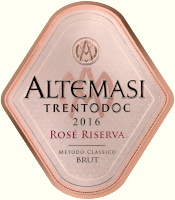
|
|
Trento Riserva Brut Rosé Altemasi 2017 |
|
| Cavit (Trentino, Italy) | |
 Pinot Nero, Chardonnay Pinot Nero, Chardonnay | |
| Price: € 38.00 | Score: |
 Brilliant cherry pink and nuances of cherry pink, transparent, fine and
persistent perlage. Brilliant cherry pink and nuances of cherry pink, transparent, fine and
persistent perlage.
 Intense, clean, pleasing, refined and elegant, starts with hints of
cherry, raspberry and strawberry followed by aromas of bread crust,
cyclamen, rose, pink grapefruit, apple, peach, tangerine, ginger, hazelnut
and cinnamon. Intense, clean, pleasing, refined and elegant, starts with hints of
cherry, raspberry and strawberry followed by aromas of bread crust,
cyclamen, rose, pink grapefruit, apple, peach, tangerine, ginger, hazelnut
and cinnamon.
 Effervescent and crisp attack, however balanced by alcohol, good body,
intense flavors, agreeable. Effervescent and crisp attack, however balanced by alcohol, good body,
intense flavors, agreeable.
 Persistent finish with flavors of cherry, raspberry and strawberry. Persistent finish with flavors of cherry, raspberry and strawberry. Refermented in bottle and aged on its lees for at least 36 months. Refermented in bottle and aged on its lees for at least 36 months. |
|
 Pasta with fish and mushrooms, Roasted fish, Roasted white meat, Mushroom soups Pasta with fish and mushrooms, Roasted fish, Roasted white meat, Mushroom soups |
|
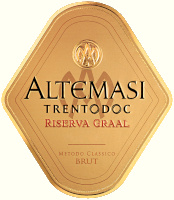
|
|
Trento Riserva Brut Altemasi Graal 2015 |
|
| Cavit (Trentino, Italy) | |
 Chardonnay (70%), Pinot Nero (30%) Chardonnay (70%), Pinot Nero (30%) | |
| Price: € 44.00 | Score: |
 Intense straw yellow and nuances of golden yellow, very transparent,
fine and persistent perlage. Intense straw yellow and nuances of golden yellow, very transparent,
fine and persistent perlage.
 Intense, clean, pleasing, refined and elegant, starts with hints of
banana, apple and bread crust followed by aromas of hawthorn, grapefruit,
plum, peach, mango, hazelnut, croissant, butter, praline, honey, mineral
and vanilla. Intense, clean, pleasing, refined and elegant, starts with hints of
banana, apple and bread crust followed by aromas of hawthorn, grapefruit,
plum, peach, mango, hazelnut, croissant, butter, praline, honey, mineral
and vanilla.
 Effervescent and crisp attack, however balanced by alcohol, good body,
intense flavors, pleasing roundness. Effervescent and crisp attack, however balanced by alcohol, good body,
intense flavors, pleasing roundness.
 Very persistent finish with long flavors of banana, apple and praline. Very persistent finish with long flavors of banana, apple and praline. Past of the base wine ferments in barrique. Refermented in bottle and
aged on its lees for 68 months. Past of the base wine ferments in barrique. Refermented in bottle and
aged on its lees for 68 months.
|
|
 Stuffed pasta, Roasted white meat, Roasted fish, Cheese Stuffed pasta, Roasted white meat, Roasted fish, Cheese |
|
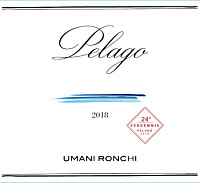
|
|
Pelago 2018 |
|
| Umani Ronchi (Marches, Italy) | |
 Cabernet Sauvignon, Merlot, Montepulciano Cabernet Sauvignon, Merlot, Montepulciano | |
| Price: € 30.00 | Score: |
 Deep ruby red and nuances of garnet red, little transparency. Deep ruby red and nuances of garnet red, little transparency. Intense, clean, pleasing, refined and elegant, starts with hints of
black cherry, plum and black currant followed by aromas of dried violet,
iris, blueberry, blackberry, cocoa, tobacco, mace, hay, laurel, leather,
vanilla and eucalyptus. Intense, clean, pleasing, refined and elegant, starts with hints of
black cherry, plum and black currant followed by aromas of dried violet,
iris, blueberry, blackberry, cocoa, tobacco, mace, hay, laurel, leather,
vanilla and eucalyptus.
 Properly tannic attack and however balanced by alcohol, full body,
intense flavors. pleasing roundness. Properly tannic attack and however balanced by alcohol, full body,
intense flavors. pleasing roundness.
 Persistent finish with flavors of black cherry, plum and black currant. Persistent finish with flavors of black cherry, plum and black currant. 14 months in barrique, 12 months in bottle. 14 months in barrique, 12 months in bottle. |
|
 Game, Roasted meat, Braised and stewed meat, Hard cheese Game, Roasted meat, Braised and stewed meat, Hard cheese |
|
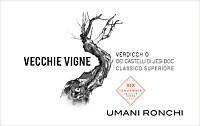
|
|
Verdicchio dei Castelli di Jesi Classico Superiore Vecchie Vigne 2020 |
|
| Umani Ronchi (Marches, Italy) | |
 Verdicchio Verdicchio | |
| Price: € 19.50 | Score: |
 Brilliant straw yellow and nuances of straw yellow, very transparent. Brilliant straw yellow and nuances of straw yellow, very transparent. Intense, clean, pleasing, refined and elegant, starts with hints of
apple, plum and hawthorn followed by aromas of broom, chamomile, pear,
peach, citrus fruits, pineapple, medlar, anise, lesser calamint, linden,
honey and almond. Intense, clean, pleasing, refined and elegant, starts with hints of
apple, plum and hawthorn followed by aromas of broom, chamomile, pear,
peach, citrus fruits, pineapple, medlar, anise, lesser calamint, linden,
honey and almond.
 Crisp attack and however balanced by alcohol, good body, intense
flavors, agreeable. Crisp attack and however balanced by alcohol, good body, intense
flavors, agreeable.
 Very persistent finish with long flavors of apple, plum and almond. Very persistent finish with long flavors of apple, plum and almond. 10 months in cement tanks, 6 months in bottle. 10 months in cement tanks, 6 months in bottle. |
|
 Stuffed pasta with fish, Roasted fish, Broiled fish, Roasted white meat, Stewed fish, Fish soups Stuffed pasta with fish, Roasted fish, Broiled fish, Roasted white meat, Stewed fish, Fish soups |
|
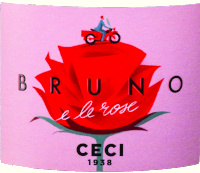
|
|
Bruno e le Rose |
|
| Ceci (Emilia-Romagna, Italy) | |
 Lambrusco (85%), Pinot Nero (15%) Lambrusco (85%), Pinot Nero (15%) | |
| Price: € 9.00 | Score: |
 Pale cherry pink and nuances of cherry pink, transparent, fine and
persistent perlage. Pale cherry pink and nuances of cherry pink, transparent, fine and
persistent perlage.
 Intense, clean, pleasing and refined, starts with hints of cherry,
raspberry and cyclamen followed by aromas of rose, strawberry, tangerine,
apple, peach, plum and blackberry. Intense, clean, pleasing and refined, starts with hints of cherry,
raspberry and cyclamen followed by aromas of rose, strawberry, tangerine,
apple, peach, plum and blackberry.
 Effervescent and crisp attack, however balanced by alcohol, good body,
intense flavors, agreeable. Effervescent and crisp attack, however balanced by alcohol, good body,
intense flavors, agreeable.
 Persistent finish with flavors of cherry, raspberry and tangerine. Persistent finish with flavors of cherry, raspberry and tangerine. Produced with the Martinotti method. Produced with the Martinotti method. |
|
 Aperitifs, Risotto with vegetables and fish, Fried fish, Cold cuts, Dairy products Aperitifs, Risotto with vegetables and fish, Fried fish, Cold cuts, Dairy products |
|
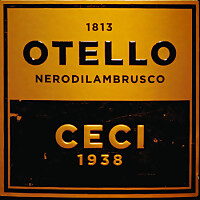
|
|
Otello Nero di Lambrusco |
|
| Ceci (Emilia-Romagna, Italy) | |
 Lambrusco Maestri Lambrusco Maestri | |
| Price: € 9.00 | Score: |
 Deep ruby red and nuances of purple red, little transparency, fine and
persistent perlage. Deep ruby red and nuances of purple red, little transparency, fine and
persistent perlage.
 Intense, clean, pleasing, refined and elegant, starts with hints of
black cherry, blackberry and blueberry followed by aromas of violet,
geranium, cyclamen, strawberry, raspberry, pomegranate and plum. Intense, clean, pleasing, refined and elegant, starts with hints of
black cherry, blackberry and blueberry followed by aromas of violet,
geranium, cyclamen, strawberry, raspberry, pomegranate and plum.
 Effervescent and crisp attack, properly tannic, however balanced by
alcohol, good body, intense flavors, pleasing hint of sweetness. Effervescent and crisp attack, properly tannic, however balanced by
alcohol, good body, intense flavors, pleasing hint of sweetness.
 Persistent finish with flavors of black cherry, blackberry and
blueberry. Persistent finish with flavors of black cherry, blackberry and
blueberry.
 Produced with the Martinotti method. Produced with the Martinotti method. |
|
 Cold cuts, Pasta with meat, Sauteed meat with mushrooms, Vegetable and mushroom soups Cold cuts, Pasta with meat, Sauteed meat with mushrooms, Vegetable and mushroom soups |
|
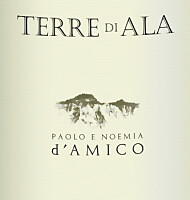
|
|
Terre di Ala 2020 |
|
| Paolo e Noemia d'Amico (Umbria, Italy) | |
 Sémillon (70%), Sauvignon Blanc (30%) Sémillon (70%), Sauvignon Blanc (30%) | |
| Price: € 14.00 | Score: |
 Brilliant straw yellow and nuances of straw yellow, very transparent. Brilliant straw yellow and nuances of straw yellow, very transparent. Intense, clean, pleasing, refined and elegant, starts with hints of
apple, citron and nettle followed by aromas of hawthorn, tomato leaf,
pineapple, grapefruit, peach, pear, melon, gooseberry and plum. Intense, clean, pleasing, refined and elegant, starts with hints of
apple, citron and nettle followed by aromas of hawthorn, tomato leaf,
pineapple, grapefruit, peach, pear, melon, gooseberry and plum.
 Crisp attack and however balanced by alcohol, good body, intense
flavors, agreeable. Crisp attack and however balanced by alcohol, good body, intense
flavors, agreeable.
 Persistent finish with flavors of apple, citron and pineapple. Persistent finish with flavors of apple, citron and pineapple. 6 months in steel tanks, 2 months in bottle. 6 months in steel tanks, 2 months in bottle. |
|
 Pasta and risotto with fish and crustaceans, Sauteed fish, Sauteed white meat with mushrooms, Legume soups Pasta and risotto with fish and crustaceans, Sauteed fish, Sauteed white meat with mushrooms, Legume soups |
|
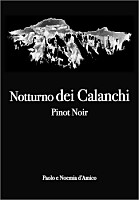
|
|
Notturno dei Calanchi 2018 |
|
| Paolo e Noemia d'Amico (Umbria, Italy) | |
 Pinot Nero Pinot Nero | |
| Price: € 30.00 | Score: |
 Brilliant ruby red and nuances of garnet red, moderate transparency. Brilliant ruby red and nuances of garnet red, moderate transparency. Intense, clean, pleasing, refined and elegant, starts with hints of
cherry, plum and raspberry followed by aromas of dried rose, cyclamen,
blueberry, strawberry, cocoa, licorice, cinnamon, leather, tobacco, vanilla
and menthol. Intense, clean, pleasing, refined and elegant, starts with hints of
cherry, plum and raspberry followed by aromas of dried rose, cyclamen,
blueberry, strawberry, cocoa, licorice, cinnamon, leather, tobacco, vanilla
and menthol.
 Properly tannic attack and however balanced by alcohol, good body,
intense flavors, pleasing crispness. Properly tannic attack and however balanced by alcohol, good body,
intense flavors, pleasing crispness.
 Persistent finish with flavors of cherry, plum and raspberry. Persistent finish with flavors of cherry, plum and raspberry. 12 months in barrique, 12 months in bottle. 12 months in barrique, 12 months in bottle. |
|
 Stuffed pasta with mushrooms, Broiled meat and barbecue, Stewed meat with mushrooms, Cheese Stuffed pasta with mushrooms, Broiled meat and barbecue, Stewed meat with mushrooms, Cheese |
|
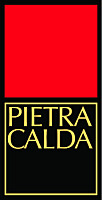
|
|
Fiano di Avellino Pietracalda 2021 |
|
| Feudi di San Gregorio (Campania, Italy) | |
 Fiano Fiano | |
| Price: € 14.00 | Score: |
 Brilliant straw yellow and nuances of straw yellow, very transparent. Brilliant straw yellow and nuances of straw yellow, very transparent. Intense, clean, pleasing, refined and elegant, starts with hints of
pear, apple and citron followed by aromas of hawthorn, chamomile, broom,
peach, plum, pineapple, medlar, linden, hazelnut and mineral. Intense, clean, pleasing, refined and elegant, starts with hints of
pear, apple and citron followed by aromas of hawthorn, chamomile, broom,
peach, plum, pineapple, medlar, linden, hazelnut and mineral.
 Crisp attack and however balanced by alcohol, good body, intense
flavors, agreeable. Crisp attack and however balanced by alcohol, good body, intense
flavors, agreeable.
 Persistent finish with flavors of pear, apple and citron. Persistent finish with flavors of pear, apple and citron. 5 months in steel tanks. 5 months in steel tanks. |
|
 Pasta with fish, Fried fish, Stewed white meat and fish, Legume soups Pasta with fish, Fried fish, Stewed white meat and fish, Legume soups |
|
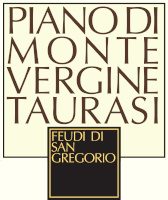
|
|
Taurasi Riserva Piano di Montevergine 2015 |
|
| Feudi di San Gregorio (Campania, Italy) | |
 Aglianico Aglianico | |
| Price: € 32.00 | Score: |
 Deep ruby red and nuances of garnet red, little transparency. Deep ruby red and nuances of garnet red, little transparency. Intense, clean, pleasing, refined and elegant, starts with hints of
plum, blackberry and dried violet followed by aromas of dried rose, black
cherry, blueberry, tobacco, cocoa, cinnamon, cigar box, leather, licorice,
rhubarb, mace, vanilla and menthol. Intense, clean, pleasing, refined and elegant, starts with hints of
plum, blackberry and dried violet followed by aromas of dried rose, black
cherry, blueberry, tobacco, cocoa, cinnamon, cigar box, leather, licorice,
rhubarb, mace, vanilla and menthol.
 Properly tannic attack and however balanced by alcohol, full body,
intense flavors, agreeable. Properly tannic attack and however balanced by alcohol, full body,
intense flavors, agreeable.
 Very persistent finish with long flavors of plum, blackberry and black
cherry. Very persistent finish with long flavors of plum, blackberry and black
cherry.
 24 months in barrique and cask, 24 months in bottle. 24 months in barrique and cask, 24 months in bottle. |
|
 Game, Roasted meat, Braised and stewed meat, Hard cheese Game, Roasted meat, Braised and stewed meat, Hard cheese |
|
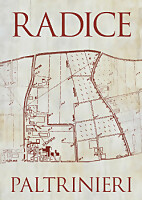
|
|
Lambrusco di Sorbara Radice 2021 |
|
| Paltrinieri (Emilia-Romagna, Italy) | |
 Lambrusco di Sorbara Lambrusco di Sorbara | |
| Price: € 11.50 | Score: |
 Intense cherry pink and nuances of cherry pink, transparent, fine and
persistent perlage. Intense cherry pink and nuances of cherry pink, transparent, fine and
persistent perlage.
 Intense, clean, pleasing and refined, starts with hints of cherry,
raspberry and apple followed by aromas of violet, rose, cyclamen,
pomegranate, pink grapefruit, strawberry and plum. Intense, clean, pleasing and refined, starts with hints of cherry,
raspberry and apple followed by aromas of violet, rose, cyclamen,
pomegranate, pink grapefruit, strawberry and plum.
 Effervescent and crisp attack, however balanced by alcohol, good body,
intense flavors. Effervescent and crisp attack, however balanced by alcohol, good body,
intense flavors.
 Persistent finish with flavors of cherry, raspberry and pink
grapefruit. Persistent finish with flavors of cherry, raspberry and pink
grapefruit.
 Produced with the method of the refermentation in bottle. Produced with the method of the refermentation in bottle. |
|
 Aperitifs, Risotto with vegetables and fish, Fried fish, Cold cuts, Dairy products Aperitifs, Risotto with vegetables and fish, Fried fish, Cold cuts, Dairy products |
|
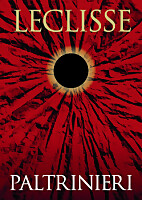
|
|
Lambrusco di Sorbara Leclisse 2021 |
|
| Paltrinieri (Emilia-Romagna, Italy) | |
 Lambrusco di Sorbara Lambrusco di Sorbara | |
| Price: € 11.50 | Score: |
 Brilliant cherry pink and nuances of cherry pink, transparent, fine and
persistent perlage. Brilliant cherry pink and nuances of cherry pink, transparent, fine and
persistent perlage.
 Intense, clean, pleasing, refined and elegant, starts with hints of
cherry, strawberry and rose followed by aromas of violet, cyclamen,
tangerine, raspberry, peach, plum, blueberry and apple. Intense, clean, pleasing, refined and elegant, starts with hints of
cherry, strawberry and rose followed by aromas of violet, cyclamen,
tangerine, raspberry, peach, plum, blueberry and apple.
 Effervescent and crisp attack, however balanced by alcohol, good body,
intense flavors, agreeable. Effervescent and crisp attack, however balanced by alcohol, good body,
intense flavors, agreeable.
 Persistent finish with flavors of cherry, strawberry and tangerine. Persistent finish with flavors of cherry, strawberry and tangerine. Produced with the Martinotti method. Produced with the Martinotti method. |
|
 Cold cuts, Meat appetizers, Pasta with meat and fish, Fried fish Cold cuts, Meat appetizers, Pasta with meat and fish, Fried fish |
|
|
||||||||
|
DiWineTaste Polls
|
| |||||||
Privacy Policy | |||||||


| Copyright © 2002-2024 Antonello Biancalana, DiWineTaste - All rights reserved |
| All rights reserved under international copyright conventions. No part of this publication and of this WEB site may be
reproduced or utilized in any form or by any means, electronic or mechanical, without permission in writing from DiWineTaste. |